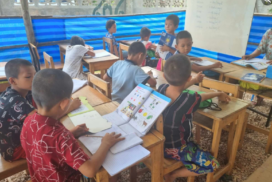By Dr Than Lwin Tun
Community-friendly primary health care prioritizes community needs, fostering collaboration between healthcare providers and residents for enhanced health and well-being.
Jointly convened by WHO and UNICEF, a report on the historic Alma-Ata conference focused world attention on primary health care as the key to achieving an acceptable level of health throughout the world.
Primary Health Care (PHC) is usually associated with the declaration of the 1978 International Conference in Alma Ata, Kazakhstan (known as the “Alma Ata Declaration”). Alma-Ata put health equity on the international political agenda for the first time, and PHC became a core concept of the World Health Organization’s (WHO) goal of Health for All. PHC is the community’s first and main point of contact with the health system. It’s about helping people live the healthiest lives possible and, when they need health care, providing the right care at the right time and in their communities.
Primary health care refers to delivering services over a person’s life courses close to where they live. These services meet most people’s health needs, including preventing and treating illness; delivering reproductive, maternal, newborn and child healthcare; managing chronic health conditions; rehabilitation; and palliative care.
PHC is a comprehensive approach to organizing and delivering services, which rests on three pillars: (1) primary care and essential public health functions as the core of integrated health services; (2) multi-sectorial policy and action; and (3) empowered people and communities. The PHC approach is often implemented in the health sector through primary care.
“PHC is a whole-of-society approach to health that aims at ensuring the highest possible level of health and well-being and their equitable distribution by focusing on people’s needs and as early as possible along the continuum from health promotion and disease prevention to treatment, rehabilitation and palliative care, and as close as feasible to people’s everyday environment,”
(WHO and UNICEF. A vision for primary health care in the 21st century: Towards UHC and the SDGs)
PHC is rooted in a commitment to social justice, equity, solidarity and participation. It is based on the recognition that the enjoyment of the highest attainable standard of health is one of the fundamental rights of every human being without distinction.
For universal health coverage (UHC) to be truly universal, a shift is needed from health systems designed around diseases and institutions towards health systems designed for people, with people. PHC requires governments at all levels to underscore the importance of action beyond the health sector to pursue a whole-of-government approach to health, including health-in-all-policies, a strong focus on equity and interventions encompassing the entire life course.
PHC addresses the broader determinants of health and focuses on the comprehensive and interrelated aspects of physical, mental and social health and well-being. It provides whole-person care for health needs throughout the lifespan, not just for a set of specific diseases. Primary health care ensures people receive quality comprehensive care –from promotion and prevention to treatment, rehabilitation and palliative care – as close as feasible to people’s everyday environment.
PHC is the most inclusive, equitable, cost-effective and efficient approach to enhancing people’s physical and mental health as well as social well-being. Evidence of the wide-ranging impact of investment in PHC continues to grow around the world, particularly in times of crisis such as the COVID-19 pandemic.
Across the world, investments in PHC improve equity and access, healthcare performance, accountability of health systems, and health outcomes. While some of these factors are directly related to the health system and access to health services, the evidence is clear that a broad range of factors beyond health services play a critical role in shaping health and well-being. These include social protection, food systems, education, and environmental factors.
PHC is also critical to make health systems more resilient to crisis situations, more proactive in detecting early signs of epidemics and more prepared to act early in response to surges in demand for services. Although the evidence is still evolving, there is widespread recognition that PHC is the “front door” of the health system and provides the foundation for strengthening the essential public health functions to confront public health crises such as COVID-19.
WHO has identified three strategic areas of work to strengthen PHC worldwide:
It provides a ‘one-stop’ mechanism for PHC implementation support to Member States, tailored to the country’s context and priorities. This includes putting into action the Operational Framework for PHC and capitalizing on investment opportunities from the COVID-19 response, building back better PHC-based health systems during recovery efforts. This core function is driven by and builds on existing work and experiences from countries and regions from across the world.
They are producing PHC-oriented evidence and innovation with a sharper focus on people left behind. This work is based on existing implementation evidence, best practice guidance and implementation solutions, expertise from successful countries, and literature published to drive innovative solutions. Key deliverables include monitoring and measurement guidance to assess PHC progress in countries and, subsequently, a Global report on PHC progress, as well as an innovative capacity-building effort as part of the WHO Academy.
It promotes PHC renewal through policy leadership, advocacy and strategic partnerships with governments, non-governmental organizations, civil society organizations, development partners, UN sister agencies, donors, and other global-, regional- and country-level stakeholders. Among other initiatives, this workstream will establish an external Strategic Advisory Group on PHC to advise the WHO on PHC renewal worldwide, it will create a PHC award for recognizing PHC excellence globally, and it will promote new PHC partnerships and collaborative networks incorporating new stakeholders such as young health leaders, parliamentarians and civil society at large.
Rethinking community-friendly primary health care is an approach to healthcare delivery that prioritizes the needs and preferences of the community it serves. It emphasizes collaboration between healthcare providers and community members to promote health and well-being. The following are some key principles and characteristics associated with community-friendly primary health care;
Community Engagement: Involving the community in decision-making processes related to healthcare planning, implementation, and evaluation, seeking input from community members to understand their unique health needs and concerns.
Cultural Competence: Recognizing and respecting the cultural diversity within the community, Adapting healthcare services to be culturally sensitive and responsive to the beliefs, values, and practices of different population groups.
Accessibility: Ensuring that healthcare services are physically and financially accessible to all community members, considering the geographical, economic, and social factors that may impact access to healthcare.
Preventive Care: Emphasizing preventive measures and health promotion to reduce the incidence of illnesses and providing education and resources to empower individuals and communities to take an active role in maintaining their health.
Collaboration: Collaborating with various healthcare professionals, community organizations, and social services to address the diverse needs of the community, Fostering teamwork and communication among healthcare providers to deliver comprehensive and integrated care.
Community-Based Services: Offering healthcare services within the community, reducing the need for individuals to travel long distances for care, and establishing local clinics, outreach programmes, and health education initiatives to engage with community members directly.
Holistic Approach: Recognizing the interconnectedness of physical, mental, and social well-being, Addressing not only immediate health concerns but also the broader determinants of health, such as housing, education, and employment.
Flexible and Responsive Services: Adapting healthcare services to changing community needs and demographics, being responsive to and proactively addressing emerging health issues.
Technology Integration: Leveraging technology to enhance healthcare delivery, such as telemedicine for remote consultations and health information systems for better data management.
Advocacy and Empowerment: Advocating for policies that support community health and well-being, Empowering individuals and communities to be active participants in their healthcare decision-making and management.
In addition, rethinking community-friendly primary health care aims to create a healthcare system that is not only effective in treating illnesses but also responsive to the unique needs and contexts of the communities it serves.
References;
1. Report of the International Conference on Primary Health Care, Alma-Ata, USSR, 6-12 September 1978
2. www.ncbi.nlm.nih.gov
3. www.who.int (Understanding Primary Health care)
4. www.who.int/news-room/fact-sheets/detail/primary-health-care














